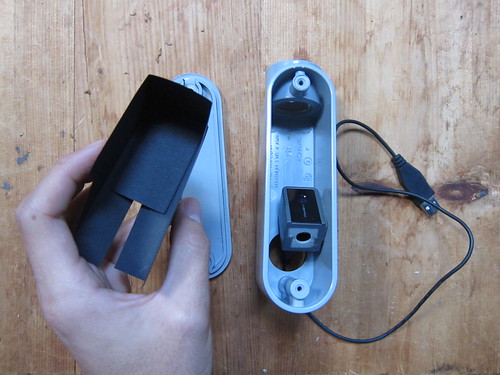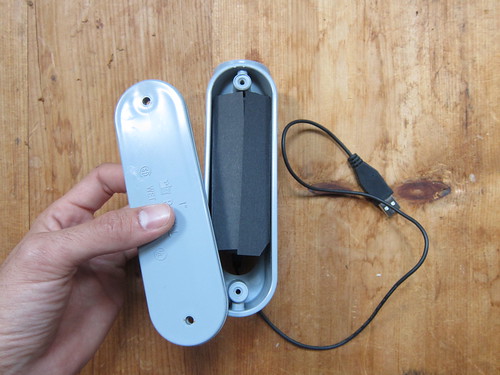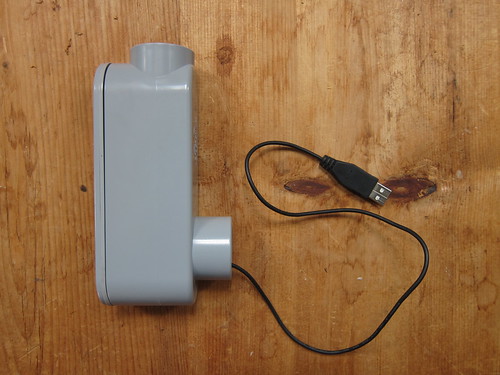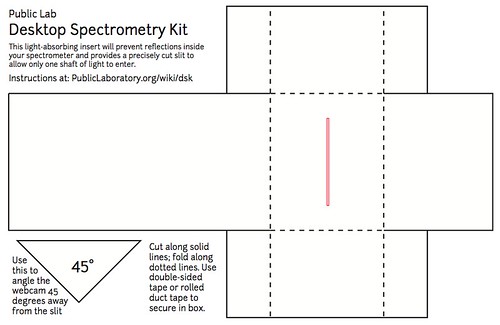Following up on this recent post. The black paper insert in the DIY Spectrometry Kit will improve the design by reducing light leakage and reflection inside the "imaging chamber". I made a couple designs -- one which i cut out and sized, and a second which i adapted to make it fit on a smaller piece of card paper. The final ones will be of stiffer black cardstock, and we're hoping to lasercut the slits.
The camera is held onto the wall with a piece of very sturdy double-sided foam tape. The only issue with this is that although I've been able to ensure that the USB cable can be unplugged from the camera back, it can be bent a bit and I worry that unless we firmly secure the cable, tugging on it will move the camera and ruin the calibration. Ideas?
Measurements coming soon, but at the bottom is a sketch with a ruler for scale. I'm still thinking about how to use the insert to help people correctly position the webcam. Also looking at ToF's design on this post and will likely adopt more of his work as the design finalizes.
Update: I modified the design so it fits on a smaller piece of paper, and tried it out. Data at the bottom, photo of new design coming soon.
Update: Here is a first-draft vector file of the design:
http://old.publiclab.org/sites/default/files/desktop-spec-insert-1.0.pdf
Update 2: Resized after testing in a conduit box:
http://old.publiclab.org/sites/default/files/desktop-spec-insert-1.1.pdf





4 Comments
Does the very short distance between the camera and the slit cause problems? I found the glue on the webcam lens very difficult to deal with, so I did not try to focus the lens at the distance for the VHS box. I tried inserting a lens between the slit and the camera, but found that I had better resolution without the "focusing/collimating lens". I am at a loss to being able to understand this. Maybe my lens was causing other effects like reflections at the lens surfaces that caused problems.
Is this a question? Click here to post it to the Questions page.
Reply to this comment...
Log in to comment
The webcams we ordered are easy to refocus -- the glue is very soft and a hair dryer can soften it more. So it's not as much an issue for these kits.
Yeah I don't know a whole lot about lens optics so I can't speculate... do you have an image online of it?
BTW, I tried to show the angle of the webcam as in your design, but was unable to get it to fit nicely onto a card, so I included the 45 degree guide and we'll have an illustrated guide showing how to align the camera instead.
Is this a question? Click here to post it to the Questions page.
Reply to this comment...
Log in to comment
I have comparative images online: https://spectralworkbench.org/spectra/show/1131 with extra focus lens https://spectralworkbench.org/spectra/show/1143 no extra focus lens
Unfortunately the two spectra are at significantly different intensities and therefore hard to compare. I think I made my judgement based on examining the spectra with my webcam viewing program as opposed to uploaded spectra.
A better spectrum was obtained by narrowing the slit as seen in: https://spectralworkbench.org/spectra/show/1144 I made the narrower slit by attaching aluminum tape to a microscope slide and and cutting a slit of say 1 mm width and then, while looking with my eye at the illuminated slit in the black paper, I slid the microscope slide back and forth along the front edge of the vhs box to get the proper alignment to form a narrow slit and then taped the microscope slide in place.
Reply to this comment...
Log in to comment
I did some reading on spectrometer designs and found what may have been my reason for not seeing the expected improvement by putting in the focusing lens (which was a focal length away from the slit and thus was also a collimating lens.) A standard spectrometer design has a slit---collimating lens----grating---imaging lens --- sensor array. The purpose of the collimating lens is to ensure that all rays incident on the grating strike the grating at the same angle. If the angle of incidence varies, then, an ideal, zero width line will actually be spread out over an angle equal to the differences in angles of incidence. Thus, even if the focus of the webcam lens is adjusted so that the slit is in focus, there will still be line spread due to the different angles of incidence on the grating. Now we need to know how much of the grating the webcam lens "sees" in order to calculate the range of incidence angles for the vhs box or the conduit box.
Now back to why I did not see an improvement in resolution using a collimating lens; I did not pay much attention to making sure that the optical axis of the collimating lens was aligned with the light path through the spectrometer, so the collimating lens was probably not not creating the desired effect of ensuring a constant angle of incidence across the grating.
For a low cost, easy to make spectrometer the incorporation of a collimating lens is probably out of the question, but comparing spectra made using different distances of slit to webcam is probably worth some examination.
Reply to this comment...
Log in to comment
Login to comment.